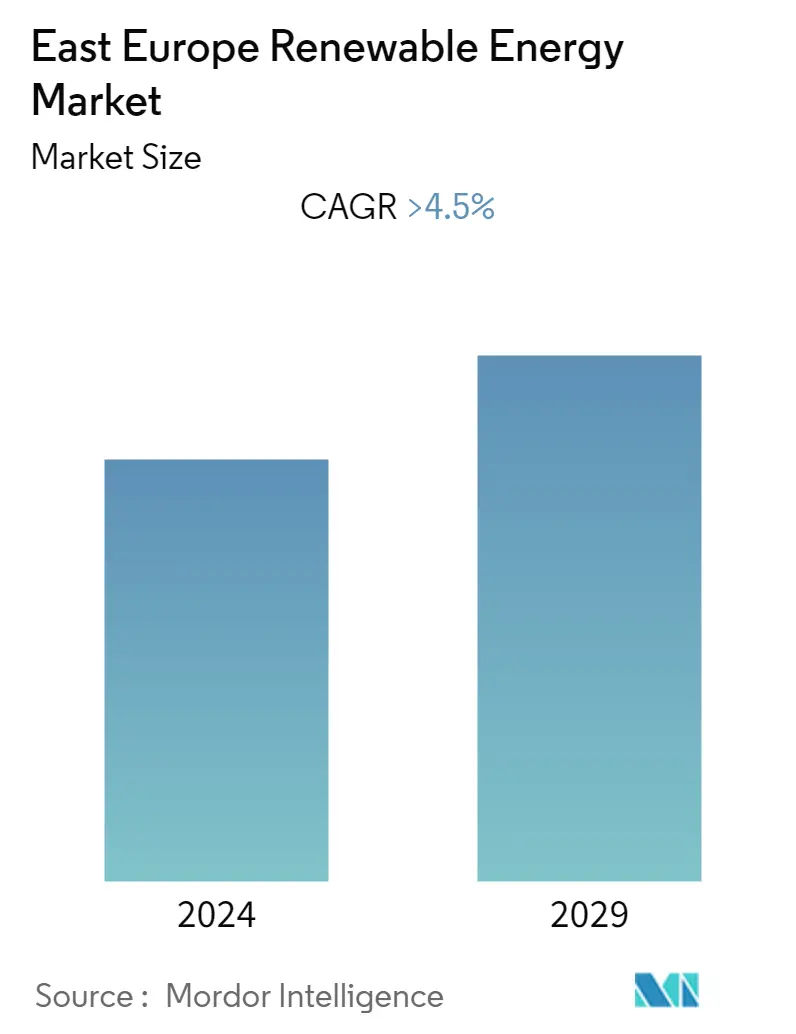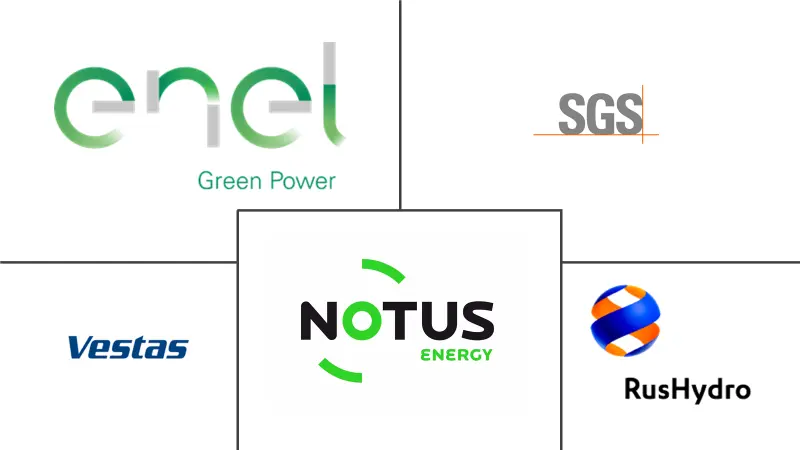Market Size of East Europe Renewable Energy Industry

| Study Period | 2021 - 2029 |
| Base Year For Estimation | 2023 |
| Forecast Data Period | 2024 - 2029 |
| Historical Data Period | 2021 - 2022 |
| CAGR | 4.50 % |
| Market Concentration | Low |
Major Players
*Disclaimer: Major Players sorted in no particular order |
East Europe Renewable Energy Market Analysis
The East Europe Renewable Energy Market is expected to grow at a CAGR of more than 4.5% during the forecast period.
COVID-19 marginally impacted the market in 2020. Presently the market has reached pre-pandemic levels.
- Over the medium term, factors such as increased environmental awareness and regulations and decreased cost per kilowatt of electricity generated are expected to boost the market.
- On the other hand, the high price of solar and wind energy storage is expected to restrain the market.
- Nevertheless, new models of solar cells made of a thin film technology that uses thin coatings of cadmium telluride in solar cells, which have higher efficiency and lower cost, may prove to be an opportunity in the sector.
- Russia is expected to dominate the renewable energy market during the forecast period in the region. Due to a significant rise in investment in renewable energy projects.
East Europe Renewable Energy Industry Segmentation
Renewable energy is energy collected from renewable resources that are naturally replenished on a human timescale. It includes sources such as sunlight, wind, water movement, and geothermal heat.
The East Europe Renewable Energy Market is segmented by type and geography. By type, the market is segmented into hydropower, solar, and others. The report also covers the market size and forecasts for the renewable energy market in major countries across the region. For each segment, the market sizing and forecasts have been done based on installed capacity (GW).
| Type | |
| Hydropower | |
| Solar | |
| Others |
| Geography | |
| Russia | |
| Poland | |
| Ukraine | |
| Others |
East Europe Renewable Energy Market Size Summary
The East Europe Renewable Energy Market is poised for significant growth, driven by increased environmental awareness and regulatory measures, alongside decreasing costs per kilowatt of electricity generated. Despite challenges such as the high cost of solar and wind energy storage, advancements in solar cell technology, particularly thin film technology, present promising opportunities. Russia is anticipated to lead the region's renewable energy sector, bolstered by substantial investments in renewable projects. The hydropower segment is expected to maintain its dominance, supported by the extensive network of dams established during the U.S.S.R era, with Russia housing the majority of these facilities. The resumption of large-scale hydroelectric projects, such as Poland's Młoty plant, underscores the continued reliance on hydropower as the primary source of renewable energy in the region.
The hydropower segment remains the most utilized form of renewable energy in East Europe, accounting for a significant portion of the region's energy production. Russia's hydroelectric power plants contribute notably to the country's electricity supply, with the Sayano-Shushenskaya plant being a key facility. However, the ongoing geopolitical tensions, particularly the Russia-Ukraine conflict, may hinder further growth in Russia's renewable energy sector due to the exit of foreign companies. The market is characterized by partial fragmentation, with key players including PJSC RusHydro, Vestas Wind Systems A/S, and Enel Green Power S.p.A. Recent developments, such as the construction of photovoltaic plants in Albania and the operation of floating PV arrays in Poland, highlight the region's expanding renewable energy landscape.
East Europe Renewable Energy Market Size - Table of Contents
-
1. MARKET OVERVIEW
-
1.1 Introduction
-
1.2 Renewable Energy Installed Capacity Forecast in GW, till 2027
-
1.3 Recent Trends and Developments
-
1.4 Government Policies and Regulations
-
1.5 Market Dynamics
-
1.5.1 Drivers
-
1.5.2 Restraints
-
-
1.6 Supply Chain Analysis
-
1.7 Porter's Five Forces Analysis
-
1.7.1 Bargaining Power of Suppliers
-
1.7.2 Bargaining Power of Consumers
-
1.7.3 Threat of New Entrants
-
1.7.4 Threat of Substitutes Products and Services
-
1.7.5 Intensity of Competitive Rivalry
-
-
-
2. MARKET SEGMENTATION
-
2.1 Type
-
2.1.1 Hydropower
-
2.1.2 Solar
-
2.1.3 Others
-
-
2.2 Geography
-
2.2.1 Russia
-
2.2.2 Poland
-
2.2.3 Ukraine
-
2.2.4 Others
-
-
East Europe Renewable Energy Market Size FAQs
What is the current East Europe Renewable Energy Market size?
The East Europe Renewable Energy Market is projected to register a CAGR of greater than 4.5% during the forecast period (2024-2029)
Who are the key players in East Europe Renewable Energy Market?
Federal Hydro-Generating Co RusHydro PAO, Vestas Wind Systems A/S, Enel Green Power S.p.A., NOTUS Energy GmbH and SGS SA are the major companies operating in the East Europe Renewable Energy Market.

